|
|
The book is written as a text for courses in computer science, computer
engineering, IT, electronic engineering, and mechatronics, as well as a guide for robot
hobbyists and researchers.
|
|

Designing Autonomous Mobile Robots

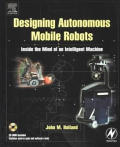 Designing
Autonomous Mobile Robots introduces the reader to the fundamental concepts of this
complex field. The author addresses all the pertinent topics of the electronic hardware
and software of mobile robot design, with particular emphasis on the more difficult
problems of control, navigation, and sensor interfacing. Designing
Autonomous Mobile Robots introduces the reader to the fundamental concepts of this
complex field. The author addresses all the pertinent topics of the electronic hardware
and software of mobile robot design, with particular emphasis on the more difficult
problems of control, navigation, and sensor interfacing.
Covering topics such as advanced sensor fusion, control systems for a wide
array of application sensors and instrumentation, and fuzzy logic applications, this
volume is essential reading for engineers undertaking robotics projects as well as
undergraduate and graduate students studying robotic engineering, artificial intelligence,
and cognitive science. Its state-of-the-art treatment of core concepts in mobile robotics
challenges readers to explore new avenues in an exciting field. The accompanying CD-ROM
provides software routines for the examples cited as well as an electronic version of the
text.
|
Authored by a well-know pioneer of mobile robotics. Learn how to approach
the design of robots and complex control system with confidence.
|
|

Introduction to Autonomous Mobile Robots

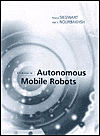 Mobile robots range from the
teleoperated Sojourner on the Mars Pathfinder mission to cleaning robots in
the Paris Metro. Introduction to Autonomous Mobile Robots
offers students and other interested readers an overview of the technology
of mobility--the mechanisms that allow a mobile robot to move through a real
world environment to perform its tasks--including locomotion, sensing,
localization, and motion planning. It discusses all facets of mobile
robotics, including hardware design, wheel design, kinematics analysis,
sensors and perception, localization, mapping, and robot control
architectures. Mobile robots range from the
teleoperated Sojourner on the Mars Pathfinder mission to cleaning robots in
the Paris Metro. Introduction to Autonomous Mobile Robots
offers students and other interested readers an overview of the technology
of mobility--the mechanisms that allow a mobile robot to move through a real
world environment to perform its tasks--including locomotion, sensing,
localization, and motion planning. It discusses all facets of mobile
robotics, including hardware design, wheel design, kinematics analysis,
sensors and perception, localization, mapping, and robot control
architectures.
The design of any successful robot involves the
integration of many different disciplines, among them kinematics, signal
analysis, information theory, artificial intelligence, and probability
theory. Reflecting this, the book presents the techniques and technology
that enable mobility in a series of interacting modules. Each chapter
covers a different aspect of mobility, as the book moves from low-level
to high-level details. The first two chapters explore low-level
locomotion, examining robots' wheels and legs and the principles of
kinematics. This is followed by an in-depth view of perception,
including descriptions of many "off-the-shelf" sensors and an analysis
of the interpretation of sensed data.
|
The final two chapters consider
the higher-level challenges of localization and cognition, discussing
successful localization strategies, autonomous mapping, and navigation
competence. Bringing together all aspects of mobile robotics into one
volume, Introduction to Autonomous Mobile Robots can serve as a
textbook for coursework or a working tool for beginners in the field.
|
|

Mobile Robotics : A Practical Introduction

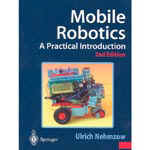 Mobile
Robotics: A Practical Introduction is an excellent introduction to the foundations
and methods used for designing completely autonomous mobile robots. Mobile
Robotics: A Practical Introduction is an excellent introduction to the foundations
and methods used for designing completely autonomous mobile robots.
A fascinating, cutting-edge research topic, autonomous mobile robotics is now taught in
more and more universities. In this book you are introduced to the fundamental concepts of
this complex field via twelve detailed case studies which show how to build and program
real working robots.
Topics covered include machine learning, autonomous navigation in unmodified, noisy and
unpredictable environments, and high fidelity mobile robot simulation.
This book provides a very practical introduction to mobile robotics for a general
scientific audience, and is essential reading for final year undergraduate students and
postgraduate students studying Robotics, Artificial Intelligence, Cognitive Science and
Robot Engineering. Its update and overview of core concepts in mobile robotics will assist
and encourage practitioners of the field, and set challenges to explore new avenues of
research in this exciting field.
|
Chapters Include:
Introduction, Foundations, Robot Hardware, Robot Learning: Making Sense of Raw Sensor
Data, Navigation, Simulation: Modeling Robot-Environment Interaction, Analysis of Robot
Behavior, Outlook, Answers to Exercises, References, Index.
We
recommend this book!
Read an excerpt from this book
|
|

Fundamentals of Robotics

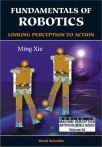 Tomorrow's robots, including humanoid
robots, will perform tasks like tutoring children, working as tour guides, driving humans
to work, and the family shopping. They will enhance our lives in ways we never dreamed
possible. No time to attend a meeting on Asian strategy? Let your robot go for you and
make the decisions. Not feeling well enough to go to the clinic? Let Dr. Robot come to
you, make a diagnosis, and get you the necessary medicine for treatment. No time to coach
the soccer team this week? Let the robot do it for you. Tomorrow's robots, including humanoid
robots, will perform tasks like tutoring children, working as tour guides, driving humans
to work, and the family shopping. They will enhance our lives in ways we never dreamed
possible. No time to attend a meeting on Asian strategy? Let your robot go for you and
make the decisions. Not feeling well enough to go to the clinic? Let Dr. Robot come to
you, make a diagnosis, and get you the necessary medicine for treatment. No time to coach
the soccer team this week? Let the robot do it for you.
|
Tomorrow's robots will be the most exciting and revolutionary things to
happen to the world since the invention of the automobile. They will change the way we
work, play, think, and live. This book will
guide you, the curious beginner, from yesterday to tomorrow. Fundamentals of Robotics
covers practical knowledge in understanding, developing, and using robots as versatile
equipment to automate a variety of industrial processes or tasks.
|
|

Computational Principles of Mobile Robotics

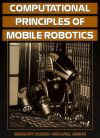 With a special emphasis on computation and algorithms, the authors address a
range of strategies for enabling robots to master problems of navigation, pose estimation,
and autonomous exploration. While they concentrate on wheeled and legged mobile robots,
they also discuss a variety of other propulsion systems with kinematic models developed
for many of the more common locomotive strategies. Chapters present algorithms for both
visual and non-visual sensor technologies, including sonar, vision, and laser scanners. In
the section on reasoning, the authors thoroughly examine the subject of planning and the
issues related to spatial representation. With a special emphasis on computation and algorithms, the authors address a
range of strategies for enabling robots to master problems of navigation, pose estimation,
and autonomous exploration. While they concentrate on wheeled and legged mobile robots,
they also discuss a variety of other propulsion systems with kinematic models developed
for many of the more common locomotive strategies. Chapters present algorithms for both
visual and non-visual sensor technologies, including sonar, vision, and laser scanners. In
the section on reasoning, the authors thoroughly examine the subject of planning and the
issues related to spatial representation.
|
A comprehensive overview of the field, Computational Principles of
Mobile Robotics is divided into three major sections: locomotion, sensing, and
reasoning. It complements its discussion of state-of-the art methods with 139
illustrations of key current and historical technologies. This is a superb textbook for
graduate and advanced undergraduate students in the field of mobile robotics.
You may also be interested in:
Algorithmic
Foundations of Robotics
Algorithmic
and Computational Robotics : New Directions
|
|

Biologically Inspired Intelligent Robots

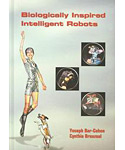 This book is a
collection reports on the technical challenges and future research trends of
building robots that emulate the appearance and behavior of biological
creatures. Topics of the 11 chapters include the development of muscle-like actuators, the principles of animated
expression and motion, haptic interfaces for human-assistive robotics,
orthotic and prosthetic technology, sensors and power supplies, robot
control, cognitive modeling for robots, and current applications that mimic
living creatures. Both black and white and color photographs are provided. This book is a
collection reports on the technical challenges and future research trends of
building robots that emulate the appearance and behavior of biological
creatures. Topics of the 11 chapters include the development of muscle-like actuators, the principles of animated
expression and motion, haptic interfaces for human-assistive robotics,
orthotic and prosthetic technology, sensors and power supplies, robot
control, cognitive modeling for robots, and current applications that mimic
living creatures. Both black and white and color photographs are provided.
Advances in biologically-inspired technologies, such as
artificial intelligence and artificial muscles, are bringing the possibility
of engineering robots that look and behave like humans closer to reality.
|
The
multidisciplinary issues involved in the development of these robots include
materials, actuators, sensors, structures, functionality, control,
intelligence, and autonomy. This book reviews various aspects ranging from
the biological model to the vision for the future.
You may also be interested in:
Biologically Inspired Robot Behavior Engineering
|
|

Biorobotics

 Animal-like robots are playing an
increasingly important role as a link between the worlds of biology and engineering. The
new, multidisciplinary field of biorobotics provides tools for biologists studying animal
behavior and testbeds for the study and evaluation of biological algorithms for potential
engineering applications. Biorobots are now enabling biologists to understand complex
animal-environment relationships. This book unites scientists from diverse disciplines who
are using biorobots to probe animal behavior and brain function. Animal-like robots are playing an
increasingly important role as a link between the worlds of biology and engineering. The
new, multidisciplinary field of biorobotics provides tools for biologists studying animal
behavior and testbeds for the study and evaluation of biological algorithms for potential
engineering applications. Biorobots are now enabling biologists to understand complex
animal-environment relationships. This book unites scientists from diverse disciplines who
are using biorobots to probe animal behavior and brain function.
The first section describes the sensory systems of
biorobotic crickets, lobsters, and ants and the visual system of flies.
The second section details the construction of a hexapod robot with
kinematics borrowed from the common cockroach. It also explores the
intriguing question of how the evolution of complex motor abilities
could lead to the development of cognitive functions.
|
The final section discusses higher brain function and neural
modeling in humanoid robots. This topic is illustrated with the help of
"Cog" the humanoid robot built by Rodney Brooks and his students at the
Artificial Intelligence Laboratory at the Massachusetts Institute of
Technology.
|
|

Map-Building and Exploration Strategies of a Simple
Sonar-Equipped Robot

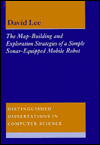 There are two radically different approaches to robot navigation.
The first is to use a map of the robot's environment; the second uses a set of built-in
reflexes to enable a robot to react rapidly to local sensory information. The
Map-Building and Exploration Strategies of a Simple Sonar-Equipped Mobile Robot
proposes a method for evaluating the different approaches, and shows how to decide which
is the most appropriate for a given robot. There are two radically different approaches to robot navigation.
The first is to use a map of the robot's environment; the second uses a set of built-in
reflexes to enable a robot to react rapidly to local sensory information. The
Map-Building and Exploration Strategies of a Simple Sonar-Equipped Mobile Robot
proposes a method for evaluating the different approaches, and shows how to decide which
is the most appropriate for a given robot.
It begins by describing "ARNE", the experimental mobile robot.
ARNE is a 12 inch diameter disc which supports the control electronics and a rotating
Polaroid sonar range-finding sensor. Below the disc is a frame that houses the motors and
shaft encoders for the two drive wheels. A bump sensor around the main disc is used to
detect collisions.
Chapters are devoted to the maps used in the research; Approaches to
exploration; The robot itself; Modeling the sonar sensor; Map construction (including a
feature based map, and a grid based map); Path planning; Localization; and Map quality
metrics.

Soccer Robotics

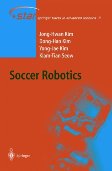
This book is a comprehensive introduction to the field of soccer
robotics. Soccer robotics has become an important research area integrating
mechatronics, computer science and artificial intelligence techniques to
create real-world autonomous systems. It also serves as a popular test arena
in which to compare the different approaches, in diverse types of
competition and with varying levels of distributed perception and
collaboration. The focus of this monograph is the FIRA framework of Soccer
Robotics, in particular the Micro Robot World Cup
Soccer Tournament, (MiroSot), which uses a central overhead camera to
view the whole soccer field and central control of the robots.
|
Soccer Robotics completely describes the
different requirements to create a soccer team and details the hardware
aspects, the computer vision needed, navigation, action selection, basic
skills and game strategy. These aspects are described at an undergraduate
level, resulting in a book not only useful as a text for courses but also
indispensable for everyone who wants to participate in
robotic competitions.
|
|

A Winning Approach to Robotic Soccer

 Robotic soccer is emerging as a standard
challenge for AI and robotics researchers. RoboCup's long-term goal is to enable the
creation of a humanoid robotic soccer team that is capable of playing on a full-size field
and beating the best human soccer team by the year 2050. This book contributes some of the
first steps towards attaining this ambitious goal, while at the same time improving our
understanding of what it takes to build complete AI agents. Robotic soccer is emerging as a standard
challenge for AI and robotics researchers. RoboCup's long-term goal is to enable the
creation of a humanoid robotic soccer team that is capable of playing on a full-size field
and beating the best human soccer team by the year 2050. This book contributes some of the
first steps towards attaining this ambitious goal, while at the same time improving our
understanding of what it takes to build complete AI agents.
Peter Stone's book is the result of six years of research as a Ph.D.
candidate and Postdoctoral Fellow in the Computer Science Department at Carnegie Mellon
University. It is about building artificially intelligent agents for real-time, noisy,
collaborative, and adversarial multiagent environments. Layered Learning in Multiagent
Systems: A Winning Approach to Robotic Soccer, Intelligent Robotics & Autonomous
Agents makes four main contributions to the fields of machine learning and multiagent
systems.
First, it describes an architecture within which a flexible team structure allows member
agents to decompose a task into flexible roles and to switch roles while acting. Second,
it presents layered learning, a general-purpose machine-learning method for complex
domains in which learning a mapping directly from agents' sensors to their actuators is
intractable with existing machine-learning methods. Third, the book introduces a new
multiagent reinforcement learning algorithm--team-partitioned, opaque-transition
reinforcement learning (TPOT-RL)--designed for domains in which agents cannot necessarily
observe the state-changes caused by other agents' actions. The final contribution is a
fully functioning multiagent system that incorporates learning in a real-time, noisy
domain with teammates and adversaries--a computer-simulated robotic soccer team.
|
Peter Stone's work is the basis for the CMUnited Robotic Soccer Team, which has dominated
recent RoboCup competitions. RoboCup not only helps roboticists to prove their theories in
a realistic situation, but has drawn considerable public and professional attention to the
field of intelligent robotics. The CMUnited team won the 1999 Stockholm simulator
competition, outscoring its opponents by the rather impressive cumulative score of 110-0.
|
|

Robot Teams

 Robot Teams : From Diversity to Polymorphism examines the
essentials of multi-agent robotics theory and provides descriptions of several systems
demonstrating the key concepts of multi-robot research. Information is presented in a
descriptive manner and augmented with mathematical formulations, photos, diagrams, and
source code examples. Robot Teams : From Diversity to Polymorphism examines the
essentials of multi-agent robotics theory and provides descriptions of several systems
demonstrating the key concepts of multi-robot research. Information is presented in a
descriptive manner and augmented with mathematical formulations, photos, diagrams, and
source code examples.
Part One: Theoretical Foundations. The first four chapters focus
on theoretical underpinnings of research in robot teams, including multirobot tasks and
rewards; a survey of existing work in multiagent and multi robot research; and metrics for
evaluating the diversity of multirobot teams. Part Two: Enabling Technologies.
Each chapter in the middle third of the book describes a "great idea" for
multirobot systems. Part Three: Robot Team Case Studies. In the final third of
the book, the authors "bring it all together" with a series of chapters
describing important implemented systems that demonstrate key aspects of robot teams.

Machines That Walk

 What is 16-feet long, 10-feet high, weighs 6,000 pounds,
has six legs, and can sprint at eight mph and step over a four-foot wall? Answer: the
Adaptive Suspension Vehicle (ASV) described in this book. What is 16-feet long, 10-feet high, weighs 6,000 pounds,
has six legs, and can sprint at eight mph and step over a four-foot wall? Answer: the
Adaptive Suspension Vehicle (ASV) described in this book.
Machines That Walk : The Adaptive Suspension Vehicle, offers an
in-depth treatment of the 'statically stable walking machine' theory employed in the
design of the ASV, the most sophisticated, self-contained, and practical walking machine
ever developed. The book includes ordering information for a 17 minute video of this
amazing machine.

Evolutionary Robotics

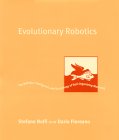 Evolutionary
robotics is a new technique for the automatic creation of autonomous robots. Inspired by
the Darwinian principle of selective reproduction of the fittest, it views robots as
autonomous artificial organisms that develop their own skills in close interaction with
the environment and without human intervention. Drawing heavily on biology and ethology,
it uses the tools of neural networks, genetic algorithms, dynamic systems, and biomorphic
engineering. The resulting robots share with simple biological systems the characteristics
of robustness, simplicity, small size, flexibility, and modularity. Evolutionary
robotics is a new technique for the automatic creation of autonomous robots. Inspired by
the Darwinian principle of selective reproduction of the fittest, it views robots as
autonomous artificial organisms that develop their own skills in close interaction with
the environment and without human intervention. Drawing heavily on biology and ethology,
it uses the tools of neural networks, genetic algorithms, dynamic systems, and biomorphic
engineering. The resulting robots share with simple biological systems the characteristics
of robustness, simplicity, small size, flexibility, and modularity.
In evolutionary robotics, an initial population of artificial chromosomes,
each encoding the control system of a robot, is randomly created and put into the
environment. Each robot is then free to act (move, look around, manipulate) according to
its genetically specified controller while its performance on various tasks is
automatically evaluated. The fittest robots then "reproduce" by swapping parts
of their genetic material with small random mutations. The process is repeated until the
"birth" of a robot that satisfies the performance criteria.
|
This book describes the basic concepts and methodologies of evolutionary
robotics and the results achieved so far. An important feature is the clear presentation
of a set of empirical experiments of increasing complexity. Software with a graphic
interface, freely available on a companion web site, will allow the reader to replicate
and vary (in simulation and on real robots) most of the experiments.
|
|

Remote Control Robotics

 The goal of Remote Control Robotics is to
enable you to control a remote robot. If you and the robot both occupy the same room, this
is a simple problem. But consider what happens if we move the robot to a different city
and supply you with a low-bandwidth connection such as the Internet. Now you have to deal
with a low resolution view of the robot and, even worse, a significant time delay. Perhaps
it is on an uneven footpath, or perhaps it is submerged on the sea floor. If the robot
were walking and it stumbled, it would crash to the ground before you even received the
first video image showing any problem. Not only can you not correct if something goes
wrong, but it's much more likely that something will go wrong. That's the subject
of this text. The aim is to let you control a remote robot efficiently, in a real
environment, via a constrained communications link. The goal of Remote Control Robotics is to
enable you to control a remote robot. If you and the robot both occupy the same room, this
is a simple problem. But consider what happens if we move the robot to a different city
and supply you with a low-bandwidth connection such as the Internet. Now you have to deal
with a low resolution view of the robot and, even worse, a significant time delay. Perhaps
it is on an uneven footpath, or perhaps it is submerged on the sea floor. If the robot
were walking and it stumbled, it would crash to the ground before you even received the
first video image showing any problem. Not only can you not correct if something goes
wrong, but it's much more likely that something will go wrong. That's the subject
of this text. The aim is to let you control a remote robot efficiently, in a real
environment, via a constrained communications link.
It begins with an introduction to the basics of robotics, then takes a historical look
at controlling remote machines, and then examine the difficulties imposed by delayed,
low-bandwidth, communications. The authors explains techniques like active force feedback,
visual clues, and techniques for diagnosing and recovering from errors. And finally, to
show that the ideas are feasible, they describe real working robots.

From Animals to Animats

 The From Animals to Animats series
brings together research intended to advance the frontier of an exciting new approach to
understanding machine intelligence. The contributors represent a broad range of interests
from artificial intelligence and robotics to ethology and the neurosciences. Unifying
these approaches is the notion of "animat" - an artificial animal, either
simulated by a computer or embodied in a robot, which must survive and adapt in
progressively more challenging environments. The contributors focus on well-defined
models, computer simulations, and they build robots in order to help characterize and
compare various principles and architectures capable of inducing adaptive behavior in real
or artificial animals. The researchers gather together about once per year to present the
results of their experiments and they are published in the Animals to Animats
series. The From Animals to Animats series
brings together research intended to advance the frontier of an exciting new approach to
understanding machine intelligence. The contributors represent a broad range of interests
from artificial intelligence and robotics to ethology and the neurosciences. Unifying
these approaches is the notion of "animat" - an artificial animal, either
simulated by a computer or embodied in a robot, which must survive and adapt in
progressively more challenging environments. The contributors focus on well-defined
models, computer simulations, and they build robots in order to help characterize and
compare various principles and architectures capable of inducing adaptive behavior in real
or artificial animals. The researchers gather together about once per year to present the
results of their experiments and they are published in the Animals to Animats
series.
|
* Adaptive behavior
* Perception
* Motor control
* Navigation
* Learning and adaptation
* Evolution
* Collective and social behaviors
* Language and communication
* Applied adapted behavior
|
|

Computer Vision and Applications

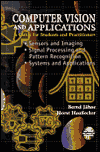 Based on the highly successful 3-volume reference Handbook
of Computer Vision and Applications, (which sells for over $1,000), this concise
edition covers in a single volume the entire spectrum of computer vision ranging form the
imaging process to high-end algorithms and applications. This book consists of three
parts: Sensors and Imaging, covering all processes involved in the formation of
an image and the sensors that convert radiation into electric signals; Signal
Processing and Pattern Recognition, focuses on processing of the spatial and
spatiotemporal signal acquired by imaging sensors; and an Application Gallery
illustrating a collection of examples of computer vision from both industry and science. Based on the highly successful 3-volume reference Handbook
of Computer Vision and Applications, (which sells for over $1,000), this concise
edition covers in a single volume the entire spectrum of computer vision ranging form the
imaging process to high-end algorithms and applications. This book consists of three
parts: Sensors and Imaging, covering all processes involved in the formation of
an image and the sensors that convert radiation into electric signals; Signal
Processing and Pattern Recognition, focuses on processing of the spatial and
spatiotemporal signal acquired by imaging sensors; and an Application Gallery
illustrating a collection of examples of computer vision from both industry and science.
Chapters include: Radiation and Illumination, Imaging Optics, Radiometry
of Imaging, Solid-State Image Sensing, Geometric Calibration of Digital Imaging Systems,
Three-Dimensional Imaging Techniques, Representation of Multidimensional Signals,
Neighborhood Operators, Motion, Three-Dimensional Imaging Algorithms, Design of Nonlinear
Diffusion Filters, Variational Methods for Adaptive Smoothing and Segmentation,
Morphological Operators, Probabilistic Modeling in Computer Vision, Fuzzy Image
Processing, Neural Net Computing for Image Processing, Applications Gallery.
This fresh approach to computer vision bridges gaps
between modern physical sciences and the many novel image acquisition
techniques; and between basic research and applications.
|
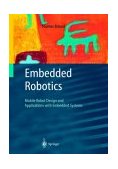 Embedded Robotics : Mobile Robot Design and Applications with
Embedded Systems presents a unique combination of mobile robots and embedded systems,
from introductory to intermediate level.
Embedded Robotics : Mobile Robot Design and Applications with
Embedded Systems presents a unique combination of mobile robots and embedded systems,
from introductory to intermediate level. Designing
Autonomous Mobile Robots introduces the reader to the fundamental concepts of this
complex field. The author addresses all the pertinent topics of the electronic hardware
and software of mobile robot design, with particular emphasis on the more difficult
problems of control, navigation, and sensor interfacing.
Designing
Autonomous Mobile Robots introduces the reader to the fundamental concepts of this
complex field. The author addresses all the pertinent topics of the electronic hardware
and software of mobile robot design, with particular emphasis on the more difficult
problems of control, navigation, and sensor interfacing. Mobile robots range from the
teleoperated Sojourner on the Mars Pathfinder mission to cleaning robots in
the Paris Metro. Introduction to Autonomous Mobile Robots
offers students and other interested readers an overview of the technology
of mobility--the mechanisms that allow a mobile robot to move through a real
world environment to perform its tasks--including locomotion, sensing,
localization, and motion planning. It discusses all facets of mobile
robotics, including hardware design, wheel design, kinematics analysis,
sensors and perception, localization, mapping, and robot control
architectures.
Mobile robots range from the
teleoperated Sojourner on the Mars Pathfinder mission to cleaning robots in
the Paris Metro. Introduction to Autonomous Mobile Robots
offers students and other interested readers an overview of the technology
of mobility--the mechanisms that allow a mobile robot to move through a real
world environment to perform its tasks--including locomotion, sensing,
localization, and motion planning. It discusses all facets of mobile
robotics, including hardware design, wheel design, kinematics analysis,
sensors and perception, localization, mapping, and robot control
architectures. Mobile
Robotics: A Practical Introduction is an excellent introduction to the foundations
and methods used for designing completely autonomous mobile robots.
Mobile
Robotics: A Practical Introduction is an excellent introduction to the foundations
and methods used for designing completely autonomous mobile robots. Tomorrow's robots, including humanoid
robots, will perform tasks like tutoring children, working as tour guides, driving humans
to work, and the family shopping. They will enhance our lives in ways we never dreamed
possible. No time to attend a meeting on Asian strategy? Let your robot go for you and
make the decisions. Not feeling well enough to go to the clinic? Let Dr. Robot come to
you, make a diagnosis, and get you the necessary medicine for treatment. No time to coach
the soccer team this week? Let the robot do it for you.
Tomorrow's robots, including humanoid
robots, will perform tasks like tutoring children, working as tour guides, driving humans
to work, and the family shopping. They will enhance our lives in ways we never dreamed
possible. No time to attend a meeting on Asian strategy? Let your robot go for you and
make the decisions. Not feeling well enough to go to the clinic? Let Dr. Robot come to
you, make a diagnosis, and get you the necessary medicine for treatment. No time to coach
the soccer team this week? Let the robot do it for you. With a special emphasis on computation and algorithms, the authors address a
range of strategies for enabling robots to master problems of navigation, pose estimation,
and autonomous exploration. While they concentrate on wheeled and legged mobile robots,
they also discuss a variety of other propulsion systems with kinematic models developed
for many of the more common locomotive strategies. Chapters present algorithms for both
visual and non-visual sensor technologies, including sonar, vision, and laser scanners. In
the section on reasoning, the authors thoroughly examine the subject of planning and the
issues related to spatial representation.
With a special emphasis on computation and algorithms, the authors address a
range of strategies for enabling robots to master problems of navigation, pose estimation,
and autonomous exploration. While they concentrate on wheeled and legged mobile robots,
they also discuss a variety of other propulsion systems with kinematic models developed
for many of the more common locomotive strategies. Chapters present algorithms for both
visual and non-visual sensor technologies, including sonar, vision, and laser scanners. In
the section on reasoning, the authors thoroughly examine the subject of planning and the
issues related to spatial representation. This book is a
collection reports on the technical challenges and future research trends of
building robots that emulate the appearance and behavior of biological
creatures. Topics of the 11 chapters include the development of muscle-like actuators, the principles of animated
expression and motion, haptic interfaces for human-assistive robotics,
orthotic and prosthetic technology, sensors and power supplies, robot
control, cognitive modeling for robots, and current applications that mimic
living creatures. Both black and white and color photographs are provided.
This book is a
collection reports on the technical challenges and future research trends of
building robots that emulate the appearance and behavior of biological
creatures. Topics of the 11 chapters include the development of muscle-like actuators, the principles of animated
expression and motion, haptic interfaces for human-assistive robotics,
orthotic and prosthetic technology, sensors and power supplies, robot
control, cognitive modeling for robots, and current applications that mimic
living creatures. Both black and white and color photographs are provided. Animal-like robots are playing an
increasingly important role as a link between the worlds of biology and engineering. The
new, multidisciplinary field of biorobotics provides tools for biologists studying animal
behavior and testbeds for the study and evaluation of biological algorithms for potential
engineering applications. Biorobots are now enabling biologists to understand complex
animal-environment relationships. This book unites scientists from diverse disciplines who
are using biorobots to probe animal behavior and brain function.
Animal-like robots are playing an
increasingly important role as a link between the worlds of biology and engineering. The
new, multidisciplinary field of biorobotics provides tools for biologists studying animal
behavior and testbeds for the study and evaluation of biological algorithms for potential
engineering applications. Biorobots are now enabling biologists to understand complex
animal-environment relationships. This book unites scientists from diverse disciplines who
are using biorobots to probe animal behavior and brain function. There are two radically different approaches to robot navigation.
The first is to use a map of the robot's environment; the second uses a set of built-in
reflexes to enable a robot to react rapidly to local sensory information. The
Map-Building and Exploration Strategies of a Simple Sonar-Equipped Mobile Robot
proposes a method for evaluating the different approaches, and shows how to decide which
is the most appropriate for a given robot.
There are two radically different approaches to robot navigation.
The first is to use a map of the robot's environment; the second uses a set of built-in
reflexes to enable a robot to react rapidly to local sensory information. The
Map-Building and Exploration Strategies of a Simple Sonar-Equipped Mobile Robot
proposes a method for evaluating the different approaches, and shows how to decide which
is the most appropriate for a given robot.
 Robotic soccer is emerging as a standard
challenge for AI and robotics researchers. RoboCup's long-term goal is to enable the
creation of a humanoid robotic soccer team that is capable of playing on a full-size field
and beating the best human soccer team by the year 2050. This book contributes some of the
first steps towards attaining this ambitious goal, while at the same time improving our
understanding of what it takes to build complete AI agents.
Robotic soccer is emerging as a standard
challenge for AI and robotics researchers. RoboCup's long-term goal is to enable the
creation of a humanoid robotic soccer team that is capable of playing on a full-size field
and beating the best human soccer team by the year 2050. This book contributes some of the
first steps towards attaining this ambitious goal, while at the same time improving our
understanding of what it takes to build complete AI agents. Robot Teams : From Diversity to Polymorphism examines the
essentials of multi-agent robotics theory and provides descriptions of several systems
demonstrating the key concepts of multi-robot research. Information is presented in a
descriptive manner and augmented with mathematical formulations, photos, diagrams, and
source code examples.
Robot Teams : From Diversity to Polymorphism examines the
essentials of multi-agent robotics theory and provides descriptions of several systems
demonstrating the key concepts of multi-robot research. Information is presented in a
descriptive manner and augmented with mathematical formulations, photos, diagrams, and
source code examples. What is 16-feet long, 10-feet high, weighs 6,000 pounds,
has six legs, and can sprint at eight mph and step over a four-foot wall? Answer: the
Adaptive Suspension Vehicle (ASV) described in this book.
What is 16-feet long, 10-feet high, weighs 6,000 pounds,
has six legs, and can sprint at eight mph and step over a four-foot wall? Answer: the
Adaptive Suspension Vehicle (ASV) described in this book. Evolutionary
robotics is a new technique for the automatic creation of autonomous robots. Inspired by
the Darwinian principle of selective reproduction of the fittest, it views robots as
autonomous artificial organisms that develop their own skills in close interaction with
the environment and without human intervention. Drawing heavily on biology and ethology,
it uses the tools of neural networks, genetic algorithms, dynamic systems, and biomorphic
engineering. The resulting robots share with simple biological systems the characteristics
of robustness, simplicity, small size, flexibility, and modularity.
Evolutionary
robotics is a new technique for the automatic creation of autonomous robots. Inspired by
the Darwinian principle of selective reproduction of the fittest, it views robots as
autonomous artificial organisms that develop their own skills in close interaction with
the environment and without human intervention. Drawing heavily on biology and ethology,
it uses the tools of neural networks, genetic algorithms, dynamic systems, and biomorphic
engineering. The resulting robots share with simple biological systems the characteristics
of robustness, simplicity, small size, flexibility, and modularity. The goal of Remote Control Robotics is to
enable you to control a remote robot. If you and the robot both occupy the same room, this
is a simple problem. But consider what happens if we move the robot to a different city
and supply you with a low-bandwidth connection such as the Internet. Now you have to deal
with a low resolution view of the robot and, even worse, a significant time delay. Perhaps
it is on an uneven footpath, or perhaps it is submerged on the sea floor. If the robot
were walking and it stumbled, it would crash to the ground before you even received the
first video image showing any problem. Not only can you not correct if something goes
wrong, but it's much more likely that something will go wrong. That's the subject
of this text. The aim is to let you control a remote robot efficiently, in a real
environment, via a constrained communications link.
The goal of Remote Control Robotics is to
enable you to control a remote robot. If you and the robot both occupy the same room, this
is a simple problem. But consider what happens if we move the robot to a different city
and supply you with a low-bandwidth connection such as the Internet. Now you have to deal
with a low resolution view of the robot and, even worse, a significant time delay. Perhaps
it is on an uneven footpath, or perhaps it is submerged on the sea floor. If the robot
were walking and it stumbled, it would crash to the ground before you even received the
first video image showing any problem. Not only can you not correct if something goes
wrong, but it's much more likely that something will go wrong. That's the subject
of this text. The aim is to let you control a remote robot efficiently, in a real
environment, via a constrained communications link. The From Animals to Animats series
brings together research intended to advance the frontier of an exciting new approach to
understanding machine intelligence. The contributors represent a broad range of interests
from artificial intelligence and robotics to ethology and the neurosciences. Unifying
these approaches is the notion of "animat" - an artificial animal, either
simulated by a computer or embodied in a robot, which must survive and adapt in
progressively more challenging environments. The contributors focus on well-defined
models, computer simulations, and they build robots in order to help characterize and
compare various principles and architectures capable of inducing adaptive behavior in real
or artificial animals. The researchers gather together about once per year to present the
results of their experiments and they are published in the Animals to Animats
series.
The From Animals to Animats series
brings together research intended to advance the frontier of an exciting new approach to
understanding machine intelligence. The contributors represent a broad range of interests
from artificial intelligence and robotics to ethology and the neurosciences. Unifying
these approaches is the notion of "animat" - an artificial animal, either
simulated by a computer or embodied in a robot, which must survive and adapt in
progressively more challenging environments. The contributors focus on well-defined
models, computer simulations, and they build robots in order to help characterize and
compare various principles and architectures capable of inducing adaptive behavior in real
or artificial animals. The researchers gather together about once per year to present the
results of their experiments and they are published in the Animals to Animats
series.  Based on the highly successful 3-volume reference
Based on the highly successful 3-volume reference